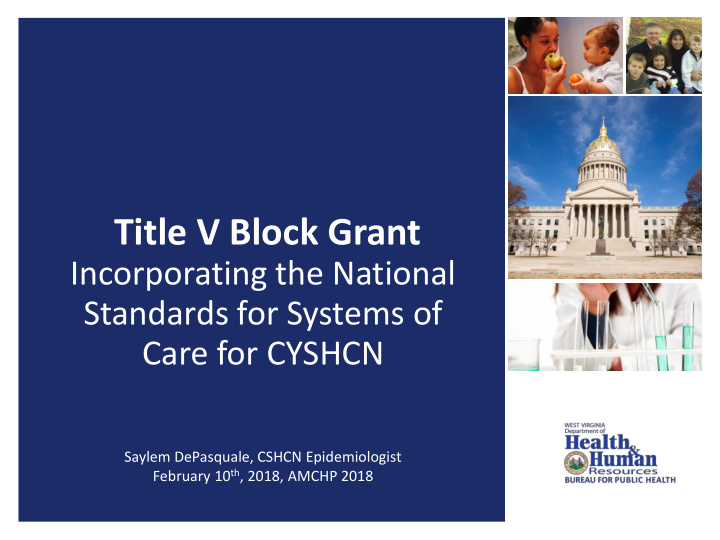



Title V Block Grant Incorporating the National Standards for Systems of Care for CYSHCN Saylem DePasquale, CSHCN Epidemiologist February 10 th , 2018, AMCHP 2018
Process Needs Assessment Priority need for CSHCN: Medical home *46.9% of CSHCN report receiving care in a medical home – 2016 NSCH Evidence base: National Standards for Systems of Care for CYSHCN 1
Burdens Facing CSHCN in West Virginia - Socioeconomic disparities - Inadequate health insurance coverage - Burdensome travel to medical appointments • Rural landscape • Little to no access to public transportation - Access to in-state pediatric specialists • Typically located around three tertiary care centers in state • Children are having to see providers out of state 2
Development of Performance Measures National Standards for Systems of Care for CYSHCN Transition Medical Home Access to Care 3
NPM 11: Medical Home Increase the percentage of children, with and without special health care needs, that have a medical home from 49% and 65% respectively in 2011/2012 to 69% by 2022. WV's rates are higher than the national average, but significant improvement is needed for children with special health care needs. ▪ Strategies: ▪ Provide financial support to provide Project Delivery of Chronic Care curriculum to resident students at two medical schools. ▪ Partner with WV HealthCheck to provide training to providers regarding the National Standards for Systems of Care for CYSHCN. ▪ Develop a shared care planning resource to facilitate communication among members of the medical home. ▪ Develop and implement care planning standards for the state Title V agency and Medicaid Managed Care Organizations and provide quality assurance monitoring to ensure these standards are being upheld. 4
SPM 1: Transition Increase the percentage of adolescents with and without special health care needs who receive services necessary to make transitions to adult health care from 41.6% in 2011 to 53.1% by 2022. Although WV's rate exceeds the national average, there is a significant opportunity for improvement. ▪ Strategies: ▪ Partner with WV HealthCheck to provide training to providers regarding the Got Transition standards. ▪ Incorporate Got Transition standards into all care planning standards and materials. ▪ Provide transition services to YSCHN. 5
SPM 2: Adequate insurance Increase the percentage of children ages 0-17 who are adequately insured from 78.2% in 2011/2012 to 83.2% by 2022. Although there are very few children not insured in WV, the insurance often does not cover nutritional needs or genetic services for children identified with special needs. ▪ Strategies: ▪ Work with insurance providers to promote the coverage of medically necessary services. ▪ Provide easily accessible, medically necessary nutrition services as a payer of last resort. ▪ Facilitate the coverage of medically necessary nutrition services by other payers (Medicaid, MCOs, private insurance, etc.). 6
Successes - Development of a shared care plan resource. - Identification of the foster care population as CYSHCN and providing health care coordination to support the foster care state agency. - Coordination of benefits through the Medicaid’s Managed Care Organizations and EPSDT benefit. - Development of Project DOCC at a second medical school to educate residents to empower families of CYSHCN. - Collaborating with Medicaid Managed Care Organizations to consistently identify CYSHCN and address their needs. - Streamlining medical foods costs to continue to provide Title V benefits as a payer of last resort. 7
Contact Saylem DePasquale CSHCN Epidemiologist saylem.m.depasquale@wv.gov Mekell Golden CSHCN Program Manager mekell.l.golden@wv.gov 8
Recommend
More recommend